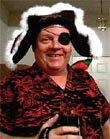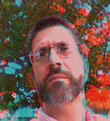|
|
 
|
|
Author
|
Topic: Changing the lamp's color temperature
|
|
|
|
|
Phil Hill
I love my cootie bug

Posts: 7595
From: Hollywood, CA USA
Registered: Mar 2000
|
 posted 02-20-2002 04:18 AM
posted 02-20-2002 04:18 AM



The only time I am concerned about color temperature is when I do a 3D theater. It is *very* important that both "eyes" have the same color temperature as dictated by the lamphouse reflector. Every reflector (at least Strong lamphouses, which I use exclusively,except for 1570) has a 3-digit letter color code that designates it's color temperature. It is imperative that these be matched for a 3D venue. Even though the xenon lamp has a "white" light, the lamphouse reflector will "color" the light. >>> Phil Mr. 3D!
| IP: Logged
|
|
John Pytlak
Film God

Posts: 9987
From: Rochester, NY 14650-1922
Registered: Jan 2000
|
 posted 02-20-2002 06:13 AM
posted 02-20-2002 06:13 AM





I agree, the dichroic coating on the reflector is probably the biggest variable in matching xenon lamphouses for color. If you are trying to match two projectors, start out with reflectors from the same batch. Port glass, lenses, lamp focus, and screen condition (as screens age, they generally get yellower) can also affect color. Contrary to popular belief, lamp current has only a minor effect.When we try to perfectly match two projectors at Kodak (for critical side-by-side comparisons of new films), we start with reflectors from the same batch, and xenon lamps of the same batch and age (hours). Even lenses of the same brand may have a slight color difference, so we try to simply switch the lenses between the two projectors to get the best color match. The final "tweek" is to use a SINGLE gelatin filter (usually a Wratten color correcting filter) in a filter holder in front of each lens. Note, using a filter to get "perfect" color match will only work on a smaller screen, as a really large lamp will fade or even warp the filter. Needless to say, the filter should be free of scratches or dirt, and monitored for any fading. Standard SMPTE 196M specifies the color temperature for theatre projection. For theatres, the light reflected from the screen should be 5400 Kelvin, with a tolerance of -200 and +600. In other words, between 5200K and 6000K. Natural daylight has a color temperature of about 5500K. ------------------
John P. Pytlak, Senior Technical Specialist
Worldwide Technical Services, Entertainment Imaging
Research Labs, Building 69, Room 7525A
Rochester, New York, 14650-1922 USA
Tel: 585-477-5325 Cell: 716-781-4036 Fax: 585-722-7243
E-Mail: john.pytlak@kodak.com
Web site: http://www.kodak.com/go/motion
| IP: Logged
|
|
Jerry Chase
Phenomenal Film Handler

Posts: 1068
From: Margate, FL, USA
Registered: Nov 2000
|
 posted 02-20-2002 11:12 AM
posted 02-20-2002 11:12 AM




"It is *very* important that both "eyes" have the same color temperature as dictated by the lamphouse reflector." (for 3-D dual strip projection)I'll have to disagree on this. The different color IS apparent at first, but within a few minutes the brain compensates and the cones balance. I work with full color anaglyphs all the time, which have about as strong a variation in color as is possible. Since my eyes have become trained, normalizing occurs within five minutes or less. After a session, for the first few minutes after I remove the red/blue glasses, one eye sees objects with a pinkish tint, the other blue. Color temperature tweaking can almost be called a subjective science, since about 9% of the population has color deficiency and a large portion of the population has other vision defects, such as night blindness, which can affect color perception at lower light levels. Jerry (member of NSA, and certified 3-D nut since age 6.) While color matching for 3-D is a nicety, and provides a good initial impression, many other factors are more important.
| IP: Logged
|
|
Pat Moore
Master Film Handler

Posts: 363
Registered: Mar 2000
|
 posted 02-20-2002 01:30 PM
posted 02-20-2002 01:30 PM




Interesting topic that seems to be getting a little more attention recently. Couple observations:Lets clarify "color temperature" and "color matching", where color matching is getting two (or more) projection sources to have the same color temperature on screen within a desired range. SMPTE 196M that John mentions specifies a color match in terms of "chromaticity", the x- & y-coordinates of the color spectrum. I don't have 196M handy to reference, but I don't remember a +/- range in Kelvin for matching in the latest document. Not all that long ago, I think it was +/- 200K, but I wouldn't bet the house on it. (John, do you remember or have a copy handy?) There are a lot of factors involved in getting the desired color temperature on screen, from reflector (to heat filter) to lamp to lens to port glass and yes, even the screen itself. It's amazing the people that do color temperature measurements without considering ambient light from things like exit signs. A few years ago I had a guy that wanted to trade out all his reflectors -- until we determined he was doing his measurements with the auditorium cleaning lights on. Oi. In my experience, the xenon lamp is fairly constant in color temperature, the main change (if any) due to age rather than variations between manufacturers, operating amperage, etc. The reflector does play perhaps the biggest part, since it's generally dichroic coated, but they are pretty consistent within batches. Some big differences come from port glas and the screen, something that's very oftem overlooked in items that affect color temperature. Pat
| IP: Logged
|
|
|
|
John Walsh
Film God

Posts: 2490
From: Connecticut, USA, Earth, Milky Way
Registered: Oct 1999
|
 posted 02-20-2002 05:35 PM
posted 02-20-2002 05:35 PM




The reason for my asking is: a person who rents our theater (single projector/platter) wanted to know if the color was correct. They weren't saying it was wrong, but they wanted some proof it was right. So, my orginal thought is not how to match two projectors, but making *any* projector conform to SMPTE standards.Not that I'm running out to get a 3-color temperature meter, anyway. I checked the price (admittedly, this was 10 years ago) for a thing made by HP, and it was about $20,000. So, it may have to remain a mystery! 
| IP: Logged
|
|
|
|
|
|
Paul Mayer
Oh get out of it Melvin, before it pulls you under!

Posts: 3836
From: Albuquerque, NM
Registered: Feb 2000
|
 posted 02-20-2002 10:38 PM
posted 02-20-2002 10:38 PM





I ran into this situation on my one-and-only dailies job here in Lost Wages (Casino)--the rental machines didn't match and both the DP (Robert Richardson) and director (Martin Scorsese) wanted them to. So Universal Pictures paid to have Technicolor fly up and read my screen with their fancy Minolta spot luminance/color temp meter (model CS-110 I think). Turned out one machine was close enough at 5500K but the other was at 6200K using the little ORC RPS-2500 lamps at 1600W on a 5x12' screen. BTW this was Super 35 with custom-cut plates to give us the 2.39 extraction without anamorphics. We used Schneider lenses.I worked out the MIRED shift values using the tables listed in the ASC Cinematographers Handbook and ended up using a 1/4 CTO gel on the bluer machine. I just taped it to the back of the shutter housing instead of projecting through it. After that I eyeballed the difference between the machines during setup each day and ended up changing the gel about once a week or so--we were cranking about six hours of dailies a day on that production, plus other special-request stuff on top of that. Lots-o-hours for four months of principal photography!  Last time I checked, that Minolta CS-110 listed for around $5800 US. As is, it reads out in x,y chromaticity coordinates and foot Lamberts, and comes with a chart for converting x,y to correlated color temp. For another $1700, Minolta supplies a little processor that connects to the meter and provides the correlated color temp directly plus printer capability. Kinda pricey! Paul
SMPTE Hollywood Section
Unemployed  mercenary film/video projectionist/engineer mercenary film/video projectionist/engineer
"Otaku wa tsurai yo" <-- Yeah I know, bad pun. Sue me.
It's tough being a fan!
-28
| IP: Logged
|
|
|
|
John Pytlak
Film God

Posts: 9987
From: Rochester, NY 14650-1922
Registered: Jan 2000
|
 posted 02-24-2002 08:14 PM
posted 02-24-2002 08:14 PM





Another possible way would be to use daylight balance KODAK Ektachrome slide film to compare the color of the illuminated screen to that of natural daylight (D5500). Photograph an "18% gray card" illuminated by D5500 Kelvin natural daylight (sunlight + skylight) during midday. On the same roll, photograph the "open gate" illuminated screen. After processing, compare the color of the gray card to the color of the screen.Note, an 18% gray card illuminated by sunlight on a clear blue sky midday will have a luminance of about 1400 footlamberts. Your screen should have 16 footlamberts. So you will need to adjust camera exposure by about 6-1/2 camera stops. But the color temperature should be nearly identical. ------------------
John P. Pytlak, Senior Technical Specialist
Worldwide Technical Services, Entertainment Imaging
Research Labs, Building 69, Room 7525A
Rochester, New York, 14650-1922 USA
Tel: 585-477-5325 Cell: 716-781-4036 Fax: 585-722-7243
E-Mail: john.pytlak@kodak.com
Web site: http://www.kodak.com/go/motion
| IP: Logged
|
|
|
|
All times are Central (GMT -6:00)
|
|
Powered by Infopop Corporation
UBB.classicTM
6.3.1.2
The Film-Tech Forums are designed for various members related to the cinema industry to express their opinions, viewpoints and testimonials on various products, services and events based upon speculation, personal knowledge and factual information through use, therefore all views represented here allow no liability upon the publishers of this web site and the owners of said views assume no liability for any ill will resulting from these postings. The posts made here are for educational as well as entertainment purposes and as such anyone viewing this portion of the website must accept these views as statements of the author of that opinion
and agrees to release the authors from any and all liability.
|

 Home
Home
 Products
Products
 Store
Store
 Forum
Forum
 Warehouse
Warehouse
 Contact Us
Contact Us




 Printer-friendly view of this topic
Printer-friendly view of this topic















 mercenary film/video projectionist/engineer
mercenary film/video projectionist/engineer


